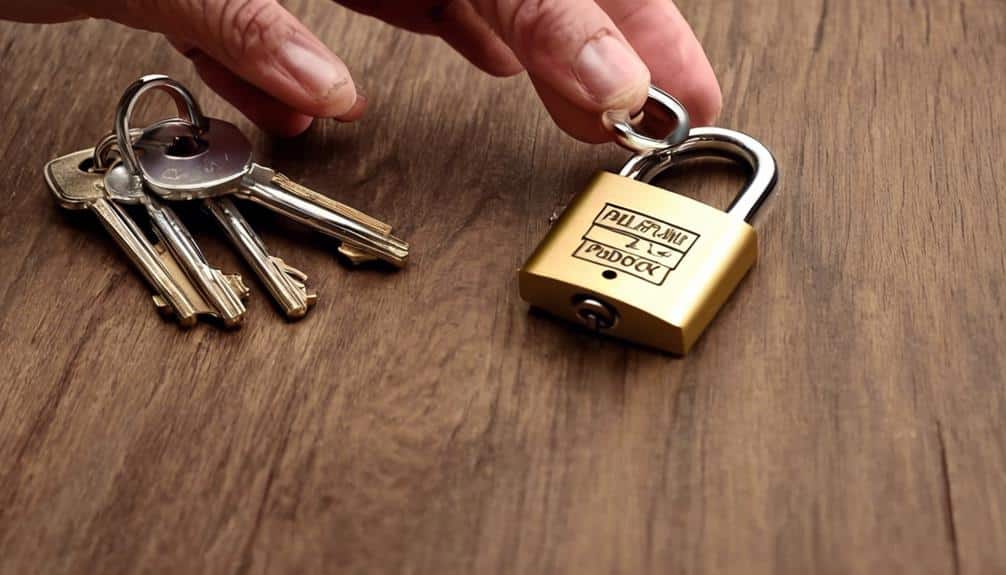So, you've found yourself in the delightful predicament of needing to duplicate a padlock key at home. Fear not, for we are here to guide you through the process with ease and finesse.
In just a few simple steps, you'll be able to create an extra key that will grant you access to your precious padlocked treasures. But before we dive into the nitty-gritty, let's take a moment to appreciate the convenience and, dare I say, thrill of being able to replicate a key at home.
Trust us, this is one discussion you won't want to miss.
Gather Necessary Materials
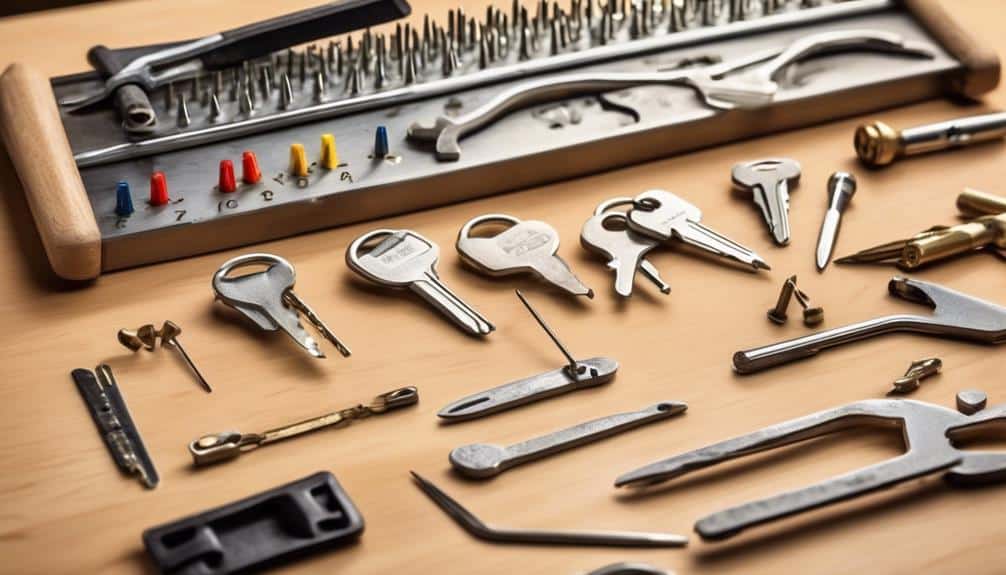
First, gather all the necessary materials for duplicating padlock keys at home. To successfully replicate a padlock key, you'll need a few essential items.
The key cutting process requires a key cutting machine, which can be purchased online or at a local hardware store. This machine is designed specifically for duplicating keys and ensures accurate and precise cuts.
Additionally, you'll need a key blank, which is a blank key that will be used as a template for creating the duplicate. Ensure that the key blank matches the type and size of the original key.
Furthermore, a key alignment technique is crucial for achieving an exact duplicate. This technique involves aligning the original key and the key blank perfectly, ensuring that they're both flush against the key cutting machine's guide. This alignment guarantees that the duplicate key will have the same ridges and notches as the original, enabling it to operate the padlock effectively.
Examine the Original Padlock Key

Let's begin by examining the original padlock key.
This step is crucial in order to understand the key's unique features and components.
Key Examination Techniques
To thoroughly examine the original padlock key, it's essential to employ precise and technical key examination techniques. This step is crucial in order to ensure accurate duplication of the key.
Firstly, inspect the key for any signs of wear or damage that may affect its functionality.
Next, use a magnifying glass to closely examine the key's teeth or ridges. These unique patterns are crucial in the key duplication process. Look for any irregularities or variations in the teeth, as these can affect the accuracy of the duplicate key.
Additionally, check the key's dimensions and compare them to the specifications required by key cutting machines. This will ensure that the duplicate key is cut to the correct size, allowing it to operate smoothly in the padlock.
Identifying Key Components
We will now examine the original padlock key in order to identify its key components. Understanding the key components is crucial to successfully duplicating a padlock key.
Here are the key components to look for:
- Key Blade: This is the part of the key that's inserted into the padlock and contains the cuts that correspond to the lock's pins.
- Key Shoulder: The shoulder is the part of the key that stops the key from being inserted too far into the lock.
- Key Bow: The bow is the handle of the key, providing a grip for turning the key.
- Key Cuts: These are the grooves on the key blade that control the movement of the lock's pins.
- Key Tip: The tip of the key is designed to align the key properly within the lock.
Choose the Right Key Blank
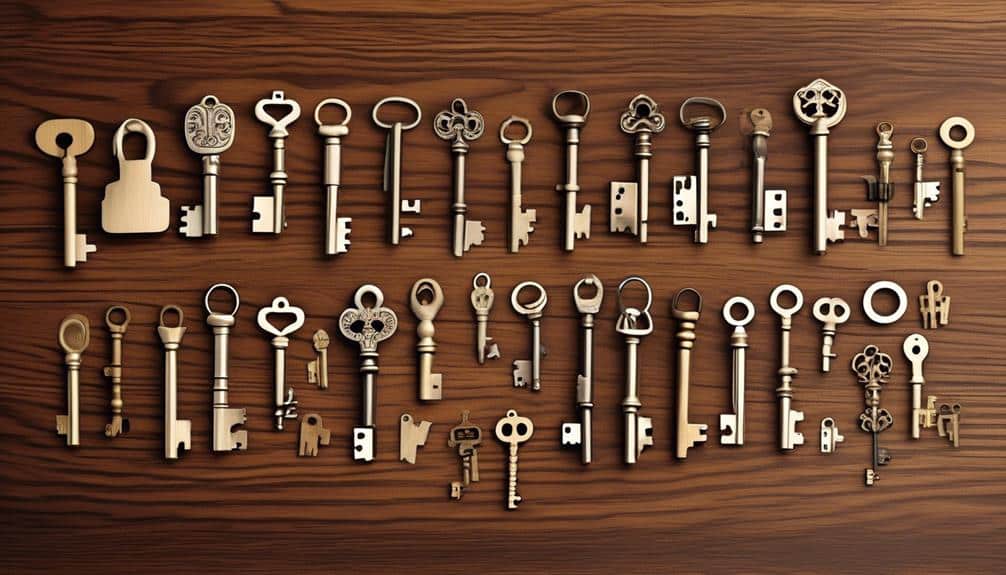
Choosing the appropriate key blank is essential when duplicating padlock keys at home. The right key blank ensures accuracy and compatibility with the lock mechanism. Key blank selection is crucial for achieving key duplication accuracy. To help you make an informed decision, we have provided a table below that outlines key blank types and their corresponding applications.
| Key Blank Type | Application |
|---|---|
| Standard | Most common type of key blank used for general-purpose padlocks. |
| High-Security | Designed for high-security padlocks, offering additional protection against picking and tampering. |
| Restricted | Restricted key blanks are patented and can only be duplicated by authorized locksmiths. These are commonly used for commercial and institutional padlocks. |
| Master | Master key blanks are used in master key systems, where a single key can open multiple locks. These are often employed in apartment buildings or office complexes. |
When selecting a key blank, consider the type of padlock you want to duplicate and its level of security. For general-purpose padlocks, a standard key blank will suffice. However, for high-security or restricted padlocks, it is crucial to choose the corresponding key blank type to ensure accurate duplication. By selecting the right key blank, you can ensure the successful duplication of your padlock key at home.
Set up a Work Area

Have you considered the importance of setting up a designated work area for duplicating padlock keys at home? Creating a proper work area is crucial for ensuring accurate and efficient key cutting techniques, as well as troubleshooting common issues. Here are five key elements to consider when setting up your work area:
- Adequate Lighting: Ensure that your work area is well-lit to clearly see the key and make precise cuts.
- Sturdy Workbench or Table: Use a stable surface to securely hold the key cutting machine and key blanks.
- Organization: Keep your tools, key blanks, and any necessary accessories organized and easily accessible.
- Safety Measures: Wear protective goggles and gloves to prevent injuries while working with sharp tools.
- Ventilation: It's important to have proper ventilation in your work area to avoid inhaling harmful fumes or dust particles.
Use a Key Cutting Machine
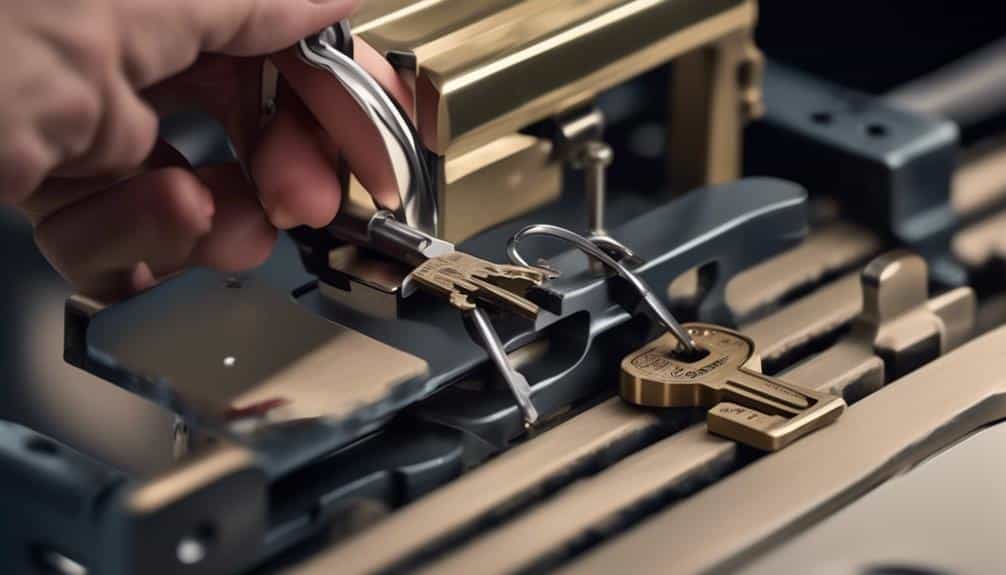
Let's talk about how to use a key cutting machine.
The key cutting process involves carefully aligning the original key with the blank key and using the machine to cut the necessary grooves and notches.
To successfully duplicate a padlock key, it's essential to have the necessary equipment, including a key cutting machine, a blank key, and a vice to hold the keys securely.
Additionally, safety precautions such as wearing protective gloves and goggles should be taken to prevent any accidents or injuries during the key cutting process.
Key Cutting Process
To duplicate padlock keys at home using a key cutting machine, we can efficiently and accurately replicate the key profile. Key cutting techniques and key duplication methods play a crucial role in this process. Here are five important steps to follow:
- Measure the original key: Use a caliper to measure the length and width of the original key accurately.
- Choose the right key blank: Select a key blank that matches the profile and dimensions of the original key.
- Set up the key cutting machine: Set the machine to the appropriate settings based on the key blank and the desired key profile.
- Position the key blank: Secure the key blank in the machine's vice, ensuring it's aligned properly.
- Cut the key: Activate the machine to cut the key, following the predetermined profile and depth specifications.
Necessary Equipment
Continuing our discussion on key cutting for duplicating padlock keys at home, one essential piece of equipment is a key cutting machine. This machine is specifically designed to accurately cut keys, ensuring a precise duplication process.
A key cutting machine consists of several key components that work together to create an exact replica of the original key. These components include a key holder, a cutting wheel, and a depth adjustment mechanism.
The key holder securely holds the original key in place, allowing it to be accurately traced onto the new key blank. The cutting wheel, powered by a motor, then cuts the new key according to the traced pattern. The depth adjustment mechanism allows for precise control over the depth of the cuts, ensuring a perfect duplication.
Safety Precautions
To ensure safe operation, it's imperative to adhere to proper safety precautions when utilizing a key cutting machine to duplicate padlock keys at home. Here are some important safety measures to consider:
- Always wear protective goggles to shield your eyes from metal shavings and debris.
- Keep your hands and fingers away from the cutting blade at all times to avoid potential injuries.
- Ensure that the key cutting machine is placed on a stable and flat surface to prevent accidents or damage.
- Read the instruction manual thoroughly before operating the machine to understand its functionality and safety guidelines.
- Regularly inspect the machine for any loose or damaged parts and refrain from using it if any issues are found.
Mark the Key Blank
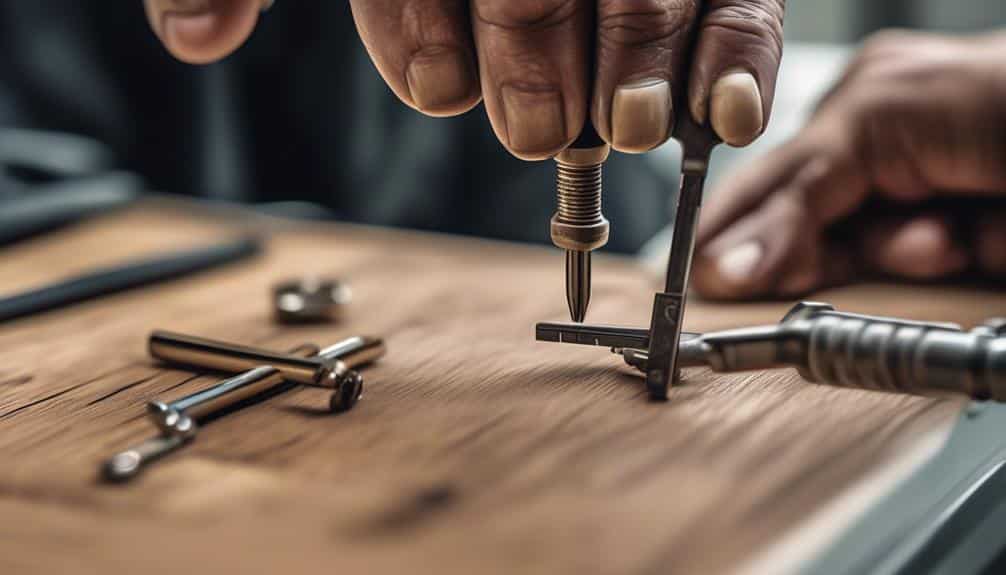
We can enhance the readability of the process by marking the key blank with an easily recognizable symbol or code. Key blank marking techniques play a crucial role in ensuring that the duplication process is accurate and efficient. By marking the key blank, we can easily identify it among a set of keys and avoid any confusion during the duplication process.
There are several key blank marking techniques that can be used. One common technique is to use a permanent marker to draw a unique symbol or code on the key blank. This can be as simple as a dot, a line, or a combination of both.
Another technique is to use a punch tool to create small indentations on the key blank. These indentations can be arranged in a specific pattern or sequence to serve as a unique identifier.
Marking the key blank not only helps with identification but also aids in key duplication troubleshooting. If any issues arise during the duplication process, such as a misalignment or an incorrect cut, the marked key blank can provide valuable information for troubleshooting the problem. By visually comparing the duplicated key to the marked key blank, we can easily identify any discrepancies and make the necessary adjustments.
Align the Original Key With the Blank
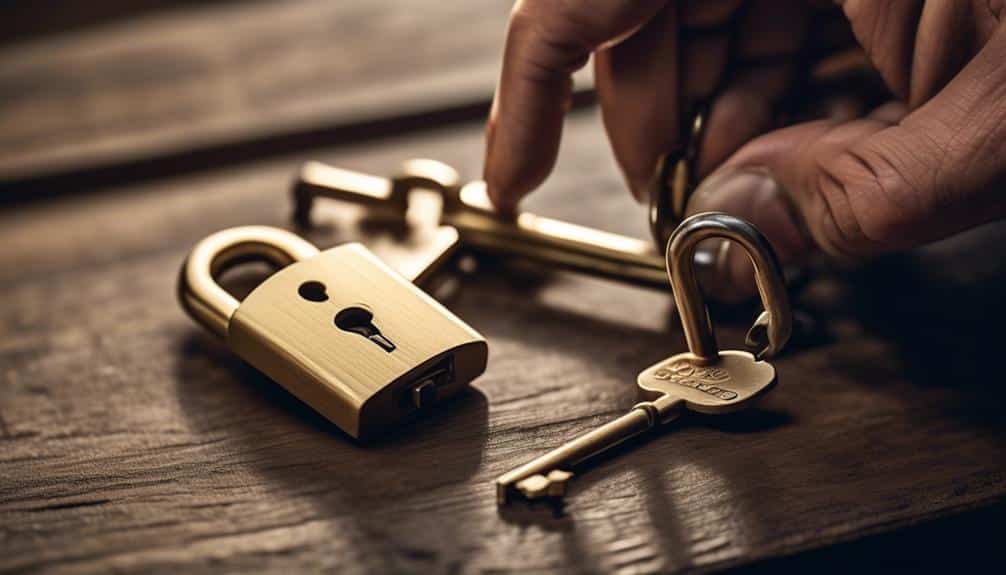
Now let's talk about aligning the original key with the blank to ensure accurate duplication.
This key alignment technique is crucial for duplicating padlock keys at home. It involves carefully positioning the original key and the blank so that they're perfectly aligned, allowing for precise duplication.
Key Alignment Technique
The key alignment technique involves aligning the original key with the blank key to ensure accurate duplication. This step is crucial in the key duplication process as it determines the precision of the cut. Here are five key points to consider when using the key alignment technique:
- Proper alignment: Place the original key and the blank key in a key cutting machine, ensuring that their teeth are aligned perfectly.
- Secure the keys: Use clamps or vices to firmly hold both keys in place during the duplication process.
- Check for accuracy: Verify that the original key and the blank key are aligned correctly by examining their teeth and ridges.
- Make adjustments if needed: If the alignment is slightly off, make necessary adjustments to ensure a precise duplication.
- Repeat the process: Once the alignment is confirmed, proceed with the key cutting techniques to duplicate the original key onto the blank key.
Proper Blank Selection
After ensuring accurate duplication through the key alignment technique, the next crucial step in duplicating padlock keys at home is selecting the proper blank that aligns with the original key.
This step is essential to ensure a successful key duplication process. When selecting a blank, it's important to choose one that matches the original key's size and shape.
The blank should have the same keyway as the original key, allowing for a seamless fit when inserted into the lock. Additionally, the material of the blank should be compatible with the cutting tools used for key duplication.
Duplicating With Precision
To achieve precise duplication, align the original key with the chosen blank, ensuring a seamless fit and accurate replication. This step is crucial in the key duplication process as any misalignment can result in an ineffective duplicate.
Here are five key points to consider when aligning the original key with the blank:
- Position the original key and the blank in a key cutting machine or a vice grip for stability.
- Ensure that the original key is fully inserted into the machine, with the blade aligned straight and centered.
- Place the blank into the machine, making sure it's aligned with the original key and securely held in place.
- Double-check the alignment by visually inspecting the original key and the blank, ensuring they're perfectly aligned.
- Once aligned, begin the cutting process, following the specific key duplication method recommended for the type of key being duplicated.
Secure the Key Blank in the Machine
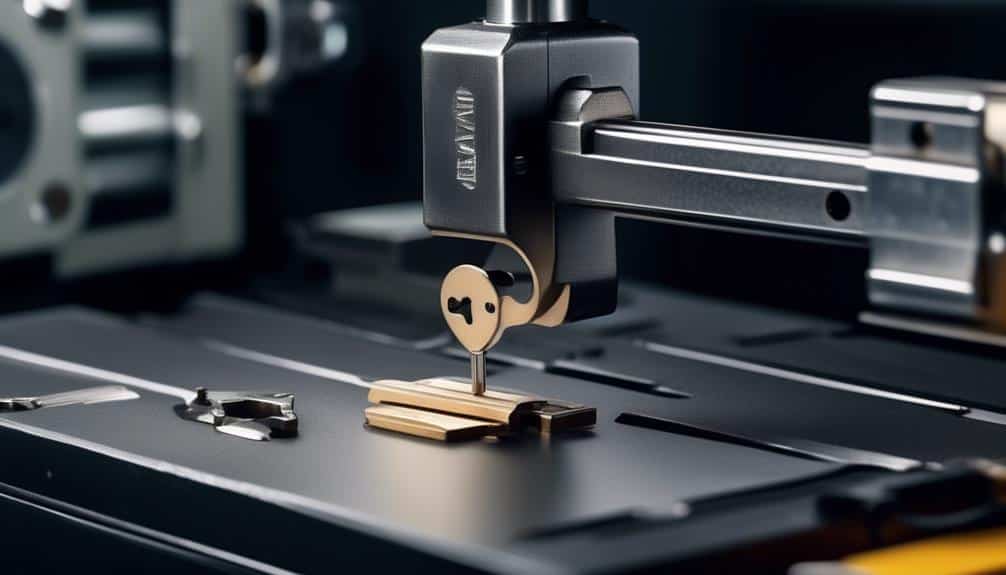
Securing the key blank in the machine is a crucial step in the process of duplicating padlock keys at home. Before we proceed, it's essential to ensure key cutting safety to prevent any accidents or damage to the machine.
To begin, make sure the key blank machine is turned off and unplugged. This will minimize the risk of injury while handling the key blank and setting it up in the machine.
Next, select the appropriate key blank that matches the original padlock key. The key blank should be securely inserted into the designated slot of the machine, ensuring that it's aligned correctly. This will guarantee a precise duplication of the key.
Once the key blank is in place, securely tighten any clamps or grips on the machine to prevent any movement during the cutting process. This will ensure accuracy and consistency in duplicating the key.
Lastly, double-check that the key blank is firmly secured in the machine before turning it on. This will minimize the chances of the key blank shifting or getting stuck during the cutting process.
Begin Cutting the Key
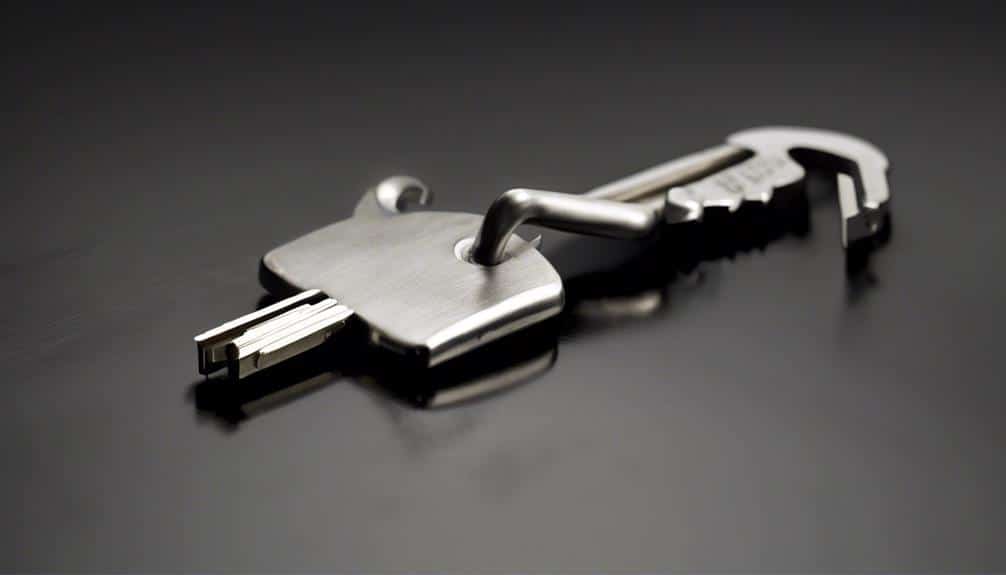
Now that the key blank is securely in place and the machine is properly set up, we can proceed to cutting the key. This step is crucial in the key duplication process as it determines the accuracy and functionality of the duplicate key.
To ensure a successful duplication, here are key cutting techniques you should follow:
- Measure and align: Use a caliper to measure the original key's dimensions accurately. Align the key blank with the original key to ensure proper positioning.
- Mark the cutting points: Use a fine-tip marker to mark the cutting points on the key blank. These marks will guide you during the cutting process.
- Select the correct cutter: Choose a cutter that matches the type of key you're duplicating. Different key types require different cutters, so make sure to select the appropriate one.
- Begin cutting: Insert the key blank into the machine and engage the cutting mechanism. Start cutting the key, following the marked cutting points precisely. Take your time and maintain a steady hand to achieve clean and accurate cuts.
- Test the key: Once the cutting is complete, remove the duplicate key from the machine. Test the key on the lock to ensure it operates smoothly and without any issues.
Test the Duplicate Key
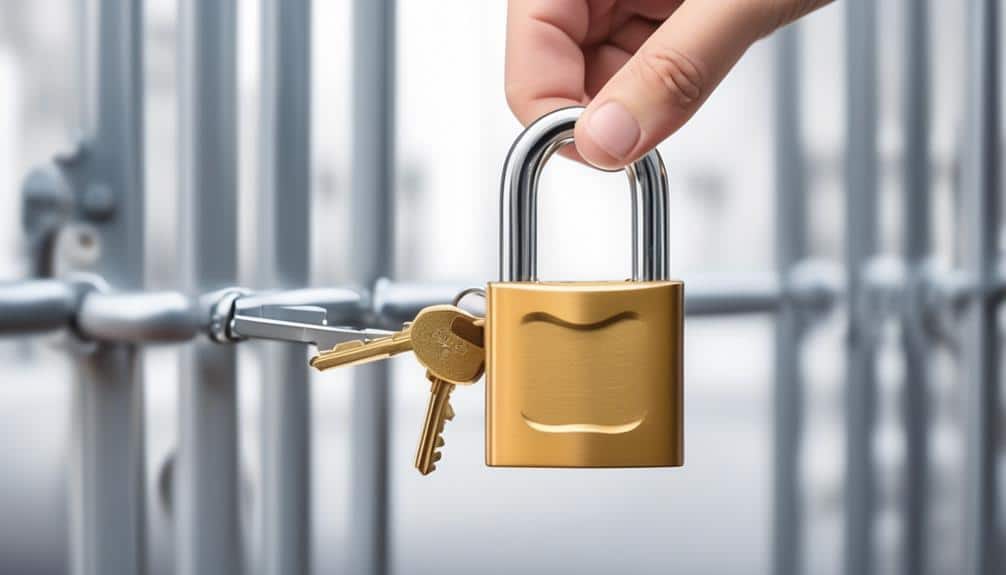
After completing the key cutting process, the next step is to thoroughly test the duplicate key to ensure its functionality and compatibility with the lock. Testing the new key is crucial to guarantee that it operates smoothly and unlocks the padlock without any issues.
To begin the testing process, we need to compare the duplicate key with the original key. This involves examining both keys side by side to check for any discrepancies in size, shape, or grooves. It's essential that the duplicate key matches the original key precisely to ensure proper functioning.
Once we've compared the keys, it's time to insert the duplicate key into the lock and test its functionality. Gently insert the key into the lock and turn it slowly to see if it smoothly opens the padlock. Pay close attention to any resistance or difficulty in turning the key, as this may indicate an issue with the duplicate key. Additionally, ensure that the key is able to fully engage with the lock mechanism and that it doesn't get stuck or jammed.
If the duplicate key successfully opens the lock without any problems, congratulations! You have successfully duplicated your padlock key. However, if you encounter any issues during the testing process, it may be necessary to revisit the key cutting process and make adjustments as needed.
Testing the duplicate key is a crucial step in ensuring its functionality and compatibility, so take the time to thoroughly test it before relying on it for everyday use.
Make Any Necessary Adjustments
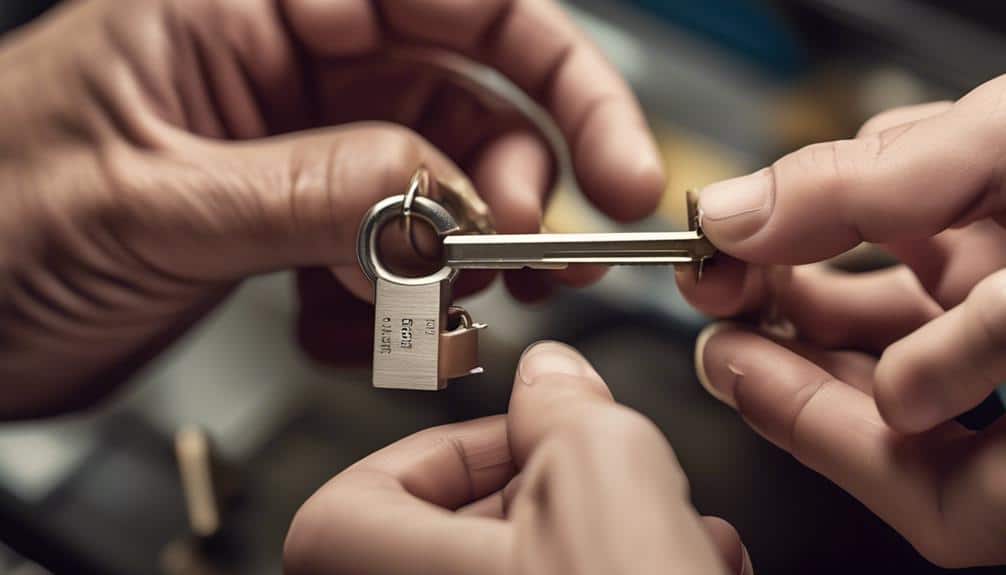
To ensure optimal functionality, carefully assess the duplicate key and make any necessary adjustments before relying on it for everyday use. Proper adjustment techniques can ensure that the key fits smoothly into the padlock and operates effectively.
Here are some troubleshooting tips to help you make any necessary adjustments:
- Check the key's alignment: Examine the duplicate key and compare it to the original key. Ensure that the grooves and ridges align perfectly to prevent any issues with insertion or rotation.
- Smooth out rough edges: Use a fine file or sandpaper to gently smooth out any rough edges or burrs on the duplicate key. This will prevent any resistance or sticking when inserting or turning the key.
- Lubricate the key: Apply a small amount of graphite powder or a silicone-based lubricant to the key. This will reduce friction and ensure smooth operation.
- Adjust key thickness: If the duplicate key is too thick or too thin, it may not fit properly into the padlock. Use a key gauge or caliper to measure the thickness and adjust it accordingly.
- Test and retest: After making adjustments, test the duplicate key multiple times in the padlock to ensure it operates smoothly and unlocks without any issues.
Safely Store the Original Key and Duplicate
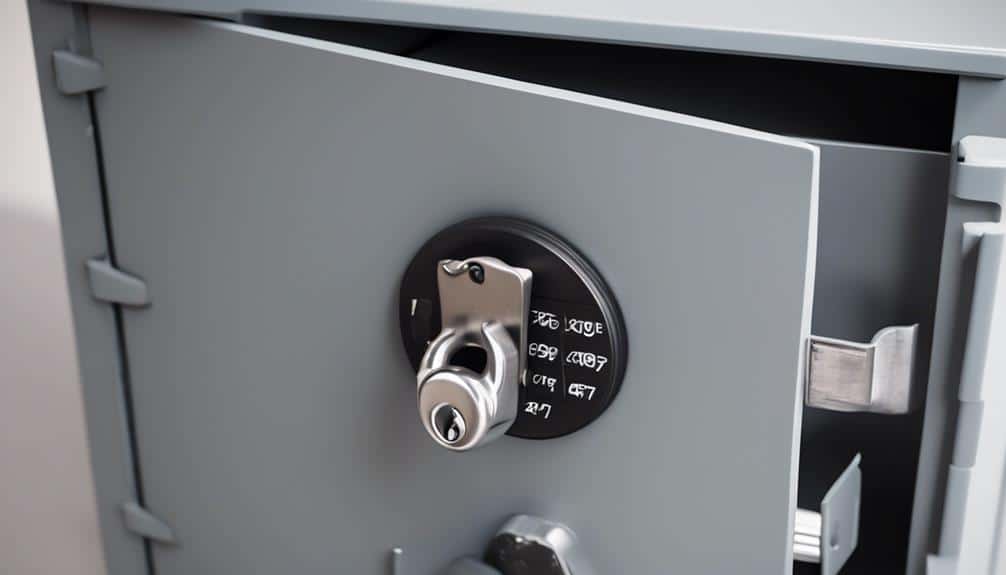
For the secure storage of both the original key and its duplicate, it's imperative to establish a designated location that ensures easy access and protection from unauthorized use. Proper key storage is crucial to avoid key duplication mistakes and maintain the security of your padlock.
To begin, choose a secure location that isn't easily visible or accessible to others. Consider using a locked drawer or a safe that requires a combination or key to open. This will prevent unauthorized individuals from gaining access to the keys.
Additionally, it's important to label the keys clearly and accurately to avoid confusion. Use a permanent marker or label maker to clearly indicate which key is the original and which one is the duplicate.
Finally, make sure to keep the keys separate from each other to prevent accidental mixing up.
Frequently Asked Questions
Can You Duplicate Any Type of Padlock Key Using These Steps?
Yes, we can duplicate certain types of padlock keys using these steps. However, it's important to note that there are limitations when it comes to duplicating certain types of padlock keys at home.
Some padlocks have advanced security features that make them more difficult to duplicate without professional assistance. Attempting to duplicate padlock keys without the necessary expertise can lead to potential risks, compromising the security of the lock or damaging the key.
Is It Possible to Duplicate a Padlock Key Without a Key Cutting Machine?
Yes, it's possible to duplicate a padlock key without a key cutting machine. However, it's important to consider the potential risks and legal implications involved in doing so.
Duplicating padlock keys at home may violate certain laws and regulations. If you don't have access to a key cutting machine, there are alternatives available such as contacting a professional locksmith who can assist you in duplicating your padlock key safely and legally.
How Long Does It Typically Take to Cut a Duplicate Key?
When it comes to cutting a duplicate key, the time it typically takes can vary depending on the complexity of the lock and the skill of the person doing the cutting.
However, there are ways to cut a duplicate key faster by using professional key cutting services.
These services offer benefits such as precision cutting and a wider range of key options.
Are There Any Safety Precautions to Keep in Mind While Duplicating a Padlock Key at Home?
When duplicating a padlock key at home, it's crucial to prioritize safety precautions.
Before diving into the process, make sure to gather the necessary tools: a key cutting machine, a blank key, and safety goggles.
Always wear your goggles to protect your eyes from any flying metal fragments.
Additionally, ensure that you're working in a well-ventilated area to avoid inhaling any harmful fumes.
Can I Duplicate a Padlock Key Even if I Don't Have the Original Key?
Sure, we can duplicate a padlock key even without the original key. However, it's important to note that this process may involve picking the padlock without a key.
One alternative to duplicating a padlock key without the original is to contact a professional locksmith who can create a new key for you.
Another option is to try using a lock picking set, although this method requires technical skills and may not always be successful.

